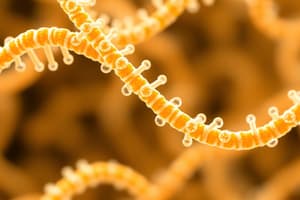Podcast
Questions and Answers
Which of the following best describes the primary function of DNA?
Which of the following best describes the primary function of DNA?
- To transfer hereditary information into proteins using ribosomes.
- To synthesize proteins directly from amino acids.
- To store and transmit hereditary information that dictates physical characteristics and predispositions. (correct)
- To act as the universal energy-carrying molecule within cells.
In a sample of DNA, if 15% of the bases are guanine (G), what percentage would be adenine (A), according to Chargaff’s rule?
In a sample of DNA, if 15% of the bases are guanine (G), what percentage would be adenine (A), according to Chargaff’s rule?
- 35% (correct)
- 30%
- 15%
- 70%
What is the type of bond that links nucleotides together during the synthesis of nucleic acids?
What is the type of bond that links nucleotides together during the synthesis of nucleic acids?
- Peptide bond
- Hydrogen bond
- Glycosidic bond
- Phosphodiester bond (correct)
Which of the following options correctly identifies the nitrogenous bases found in RNA?
Which of the following options correctly identifies the nitrogenous bases found in RNA?
Which characteristic is exclusive to DNA compared to RNA?
Which characteristic is exclusive to DNA compared to RNA?
Which statement best describes how ATP releases energy?
Which statement best describes how ATP releases energy?
If a segment of a DNA template strand reads 5'-ATTCGTCA-3', what would be the sequence of the complementary RNA strand?
If a segment of a DNA template strand reads 5'-ATTCGTCA-3', what would be the sequence of the complementary RNA strand?
What role does the enzyme ligase play in nucleic acid synthesis?
What role does the enzyme ligase play in nucleic acid synthesis?
Flashcards
Nucleic Acids
Nucleic Acids
Large organic molecules made of chains of nucleotides, responsible for storing and transferring genetic information.
DNA (Deoxyribonucleic Acid)
DNA (Deoxyribonucleic Acid)
A type of nucleic acid that stores the genetic blueprint of an organism, determining its traits.
RNA (Ribonucleic Acid)
RNA (Ribonucleic Acid)
A type of nucleic acid responsible for converting genetic information from DNA into proteins.
Nucleotides
Nucleotides
Signup and view all the flashcards
DNA Bases
DNA Bases
Signup and view all the flashcards
RNA Bases
RNA Bases
Signup and view all the flashcards
Chargaff's Rule
Chargaff's Rule
Signup and view all the flashcards
ATP (Adenosine Triphosphate)
ATP (Adenosine Triphosphate)
Signup and view all the flashcards
Study Notes
Nucleic Acids
- Nucleic acids are macromolecules formed from chains of nucleotides.
- DNA (deoxyribonucleic acid) stores hereditary information, including physical traits, protein structure, and disease predisposition.
- RNA (ribonucleic acid) helps transfer hereditary information to create proteins.
- ATP (adenosine triphosphate) is the universal energy-carrying molecule.
Nucleotides
- Nucleotides are the monomers of nucleic acids.
- A nucleotide consists of a phosphate group, a sugar (deoxyribose or ribose), and a nitrogenous base.
- Nitrogenous bases include: adenine (A), guanine (G), cytosine (C), thymine (T), and uracil (U). Thymine is found in DNA, uracil in RNA.
- Purines (adenine and guanine) are larger than pyrimidines (cytosine, thymine, and uracil).
Nucleic Acid Synthesis
- Nucleotides link together via phosphodiester bonds to form a nucleic acid.
Examples of Nucleic Acids: DNA vs. RNA
| Feature | DNA | RNA |
|---|---|---|
| # of strands | Double strand | Single strand |
| Type of sugar | Deoxyribose | Ribose |
| Nitrogen bases | A, C, G, T | A, C, G, U |
| Complementary base pairs? | Yes | No |
| Hydrogen bonds? | Yes | No |
| Backbone | Sugar and phosphate | Sugar and phosphate |
| Location in cell | Nucleus | Nucleus, cytoplasm |
DNA Structure
- DNA is a double helix.
- The two strands of DNA are antiparallel (5' to 3' and 3' to 5').
- The structure of DNA allows for complementary base pairing between A and T, and C and G.
- The distance between base pairs is 0.34 nm. The distance between two twists (turns) is 3.4 nm.
RNA Structure
- RNA is a single-stranded molecule.
- RNA contains uracil (U) instead of thymine (T)
- The base pairs are A and U, and C and G.
Chargaff's Rule
- Chargaff's rule states that the amount of adenine equals the amount of thymine (A=T), and the amount of guanine equals the amount of cytosine (G=C) in DNA.
- This rule applies to all organisms.
Complementary Base Pairing
- Complementary base pairs are crucial for accurately replicating and transcribing genetic information.
ATP
- ATP is a special nucleotide, the universal energy-carrying molecule.
- High-energy bonds between phosphate groups in ATP release energy when broken.
- AMP is a nucleotide with only one phosphate group.
Studying That Suits You
Use AI to generate personalized quizzes and flashcards to suit your learning preferences.




